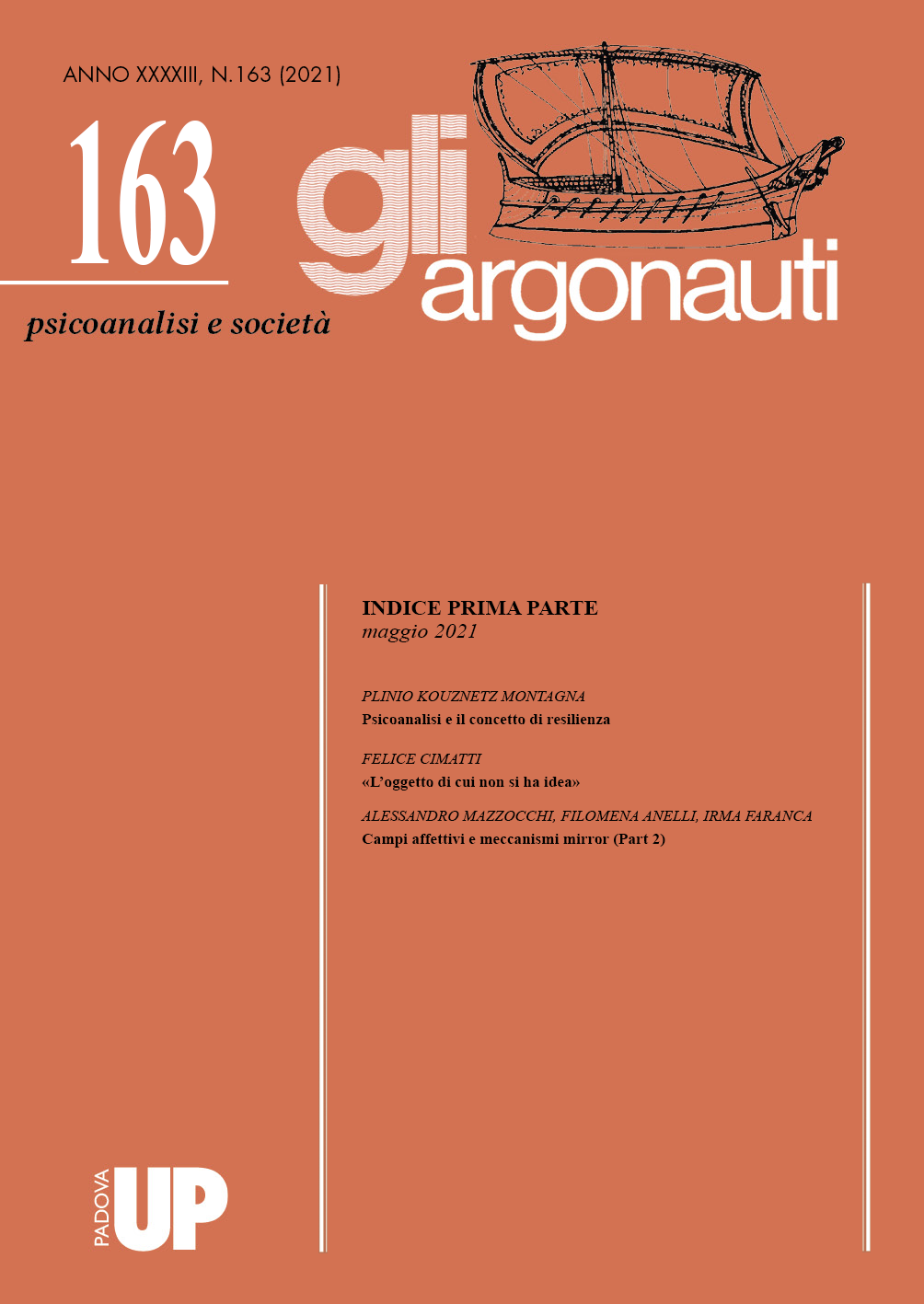
Gli Argonauti N° 163 (1° parte) – Maggio 2021
SAGGI
Plinio Kouznetz Montagna
Psicoanalisi e il concetto di resilienza
[Scarica l’articolo in formato .PDF]
Traduzione di Iara Morata Martines e Renato Davi
Abstract: L’autore risale all’origine del termine resilienza e alla sua appropriazione da parte di molte aree della conoscenza, considerando che esso dà risalto a una focalizzazione sulla sanità, non centrata sulla patologia. Ciò è in linea con la psicoanalisi che è rivolta alla crescita e allo sviluppo umani. Il suo uso in psicoanalisi avviene nella considerazione dei processi sia intrapsichici che interpersonali. È importante la distinzione tra resilienza e pseudo-resilienza. L’autore esamina l’analista come il così definito “tutor di resilienza”; riflette su aspetti del trauma e del lutto, anche attraverso brevi illustrazioni cliniche.
Keywords: Resilienza, Lutto, Trauma, Capacità dell’Io, Tutor di resilienza.
Psychoanalysis and the concept of resilience
Abstract: The author traces the origin of the term resilience and its appropriation by several areas of knowledge, commenting that it brings to the medical literature a focus on health, and not centered on pathology. This is in line with psychoanalysis, which targets human growth and development. Its use by the latter occurs with consideration of both intrapychic and interpersonal processes. The distinction between resilience and pseudo-resilience is relevant. He observes the analyst as the so-called resilience tutor, discusses aspects of trauma and grief and presents brief clinical illustrations.
Keywords: Resilience, Mourning, Trauma, Egoic capacity, Resilience Tutor.
Felice Cimatti
«L’oggetto di cui non si ha idea»
[Scarica l’articolo in formato .PDF]
Abstract: Essere umano significa essere un vivente scosso dall’enigmaticità dell’Altro, un’enigmaticità che nessuno dei “codici” naturali di cui l’infans dispone alla nascita è in grado di sciogliere. L’inconscio, per Laplanche, è questo “altro” non tradotto che continua a pungolare la soggettività umana. In effetti i «messaggi enigmatici» si depositano letteralmente come residui cosali: si pensi al significante linguistico, che non è altro che una vibrazione sonora, oppure alla ‘scia’ somatica lasciata da una carezza ambigua sull’epidermide. Tolto il valore semantico di questi segni ne rimane tuttavia la traccia materiale. Il problema che si pone è se il ‘soggetto’ umano riuscirà mai a trovare un modo per convivere con questa radicale alterità a sé stesso.
Keywords: Freud, Laplanche, dualismo pulsionale, inconscio, Altro.
Such an object of which you have no idea
Abstract: To be human means to be a living being shaken by the enigmatic nature of the Other, an enigmatic nature that none of the natural “codes” available to the infans at birth are able to dissolve. The unconscious, for Laplanche, is such an untranslated “other” that keeps prodding human subjectivity. Indeed, those “enigmatic messages” of the Other are literally deposited as material residues: think of the linguistic signifier, which is nothing more than a sound vibration, or of the somatic “trail” left by an ambiguous caress on the epidermis. Once the semantic value of these obscure signs has been removed, however, the material trace remains. The problem that arises is whether the human ‘subject’ will ever be able to find a way to live with this radical otherness to her/himself.
Keywords: Freud, Laplanche, drive dualism, unconscious, Other.
Alessandro Mazzocchi, Filomena Anelli, Irma Faranca
Campi affettivi e meccanismi mirror (Part 2)
[Scarica l’articolo in formato .PDF]
Abstract: Si discute il possibile ruolo svolto dai meccanismi mirror e dall’embodied simulation nell’ambito del “team lattante-madre proiettante- contenitore” e, più in generale, nelle relazioni affettive emotivamente pregnanti. Si fa riferimento al lavoro di W. Bion (rêverie), per conciliarlo con le moderne acquisizioni della neurofisiologia, partendo dal concetto moderno di trans- identificazione di Grotstein. Così, attraverso i mirror neurons, nel campo bi- personale, è possibile il trasferimento immediato di informazioni da un soggetto all’altro senza processi mentali intermedi, e ciò è alla base della nascita della struttura fondamentale dell’essere umano, il Sé, durante la relazione madre-bambino.
Keywords: trans-identificazione proiettiva, neuroni specchio, simulazione incarnata, rêverie, campo psicodinamico.
Affective fields and mirror mechanisms
Abstract: The possible role played by the mirror mechanisms and the embodied simulation in the context of the “infant-mother projecting-container team” is discussed. More generally, these mechanisms are analyzed in the meaningful emotional relationships. The work of Bion has been considered, to reconcile it with the modern discoveries of neurophysiology, from Grotstein’s modern concept of trans-identification. Through mirror neurons, the immediate transfer of information from one subject to another is possible in the bi-personal field, without intermediate mental processes. This would represent the basis of the fundamental structure of the human being, the Self, during the mother-child relationship.
Keywords: projective trans-identification, mirror neurons, embodied simulation, rêverie state, psychodinamic fields


